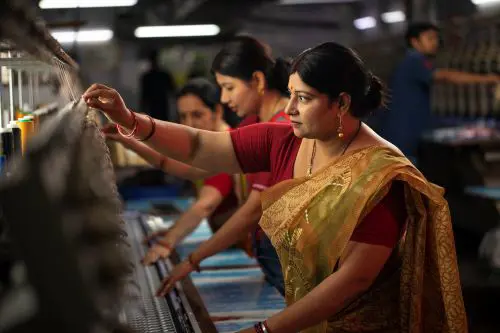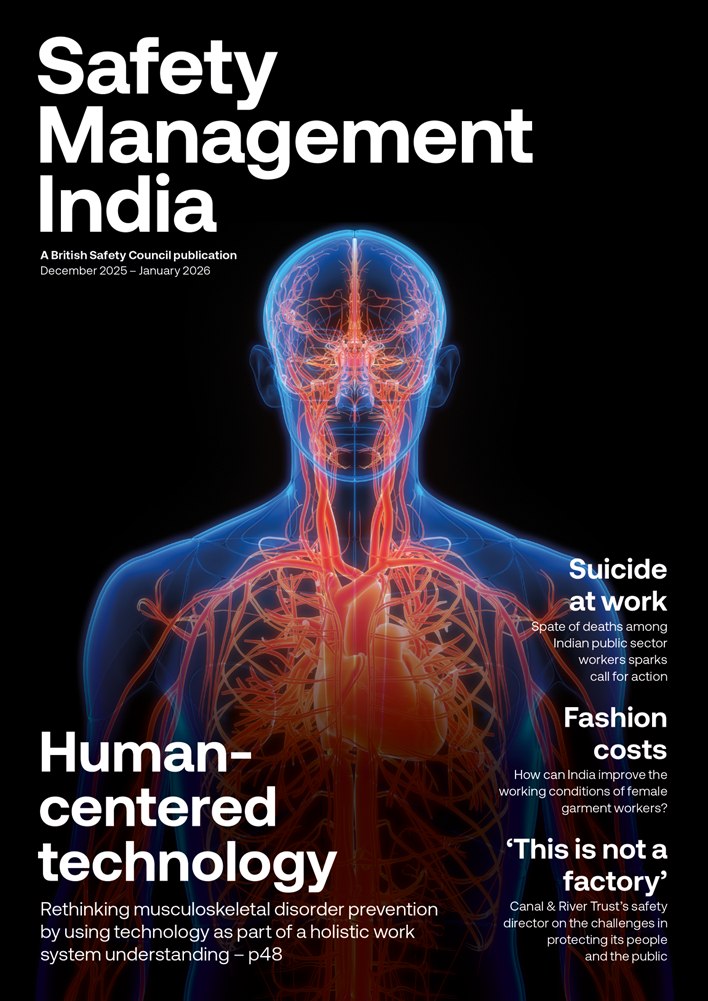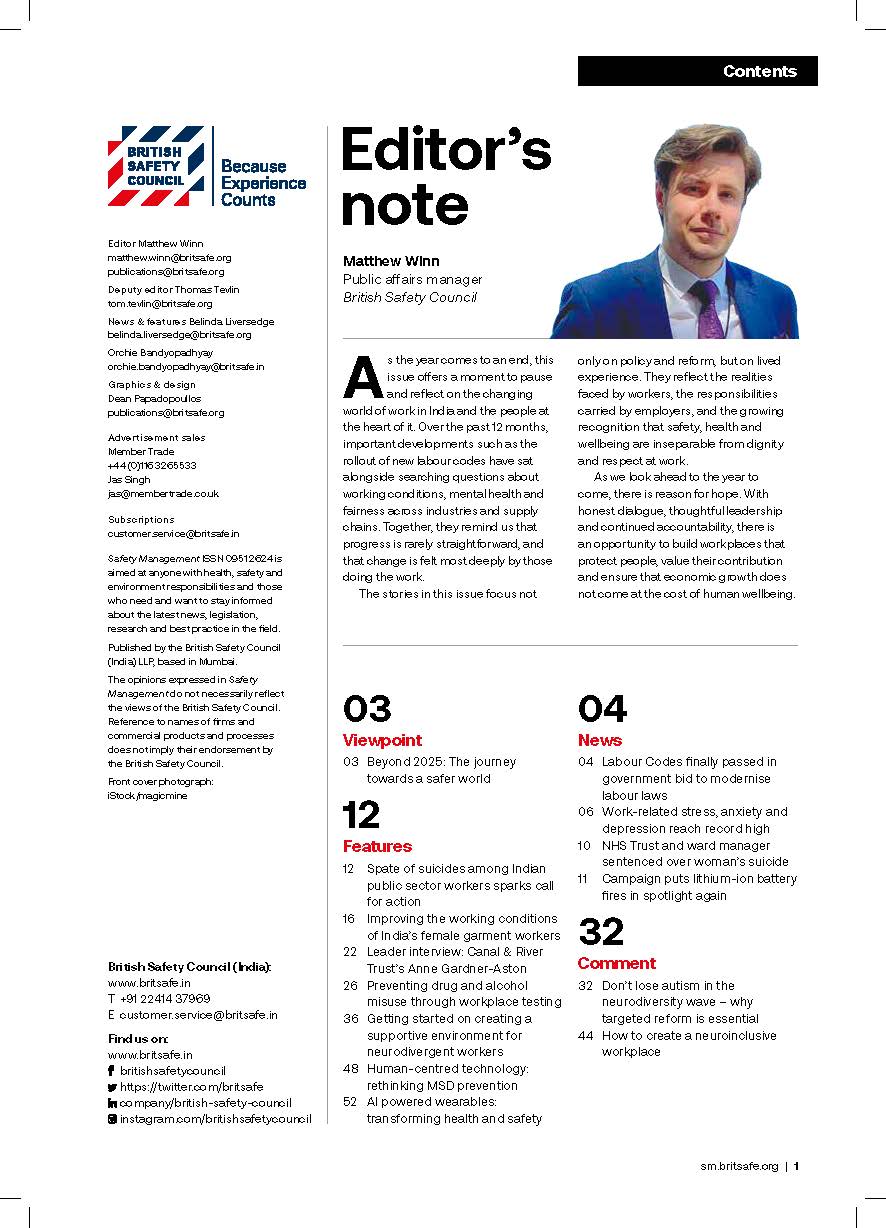Although India recently joined the rest of the world in marking World Day for Safety and Health at Work, a spate of fatal accidents in the run-up to the day has again prompted calls for tougher legislation and employer action to protect Indian workers from work-related injury and ill health.
Features
Boosting health and safety in India: major challenges remain
On 26 April, three sanitation labourers were killed after inhaling poisonous gas while working in a septic tank at an under-construction residential building in West Bengal’s Nadia district.
A preliminary investigation found that the labourers had gone into the tank to conduct an inspection without using the proper safety equipment.
However, soon after, for reasons as yet unknown, the air quality inside the tank deteriorated quickly, leading to the workers losing consciousness. The other workers who were waiting outside the tank raised the alarm when they realised that something had gone wrong.
 Credit: CS Sharad Prasad/Flickr https://www.flickr.com/photos/sharadaprasad/albums
Credit: CS Sharad Prasad/Flickr https://www.flickr.com/photos/sharadaprasad/albums
Meanwhile, in a separate incident around a week earlier on the night of 17-18 April, four migrant workers were killed and 20 injured after a three-story rice mill building, which was being used as accommodation by the labourers, collapsed at Karnal in Haryana.
Nearly 200 labourers were sleeping when the roof of the building’s top floor collapsed at around 3am at the Shiv Shakti rice mill in Taraori town in Karnal.
“Four labourers hailing from Samastipur in Bihar have died in the incident and 20 were injured,” Karnal’s Superintendent of Police Shashank Kumar told news agency PTI.
This fatal incident has once again highlighted a much-ignored issue – the poor living conditions provided to casual migrant workers by their employers.
In his complaint to police following the deaths, labour contractor Ramdev Mehto, who provided migrant labourers to work at the rice mill, said the labour quarters had been constructed near the rice mill to ensure the round-the-clock availability of workers. “But nothing was done to ensure the safety of the workers,” he said.
The building was quite old and dilapidated and water from the toilet and kitchen was seeping into its foundation. Mehto says he warned the rice mill owners about the poor condition of the living quarters and the building on several occasions but his requests were ignored and no action was taken.
The incident could have been avoided if appropriate measures been taken. According to the FIR (First Information Report) drawn up by police investigating the deaths, the owners of the mill were allegedly negligent in ensuring the safety of the workers’ accommodation.
A committee responsible for investigating the circumstances of the building collapse has been formed under the chairmanship of Karnal’s sub-divisional magistrate and an executive engineer of the public works department. An official from the Haryana government’s Labour Department is also part of the investigation team.
DP Singh, deputy director of industrial safety and health at Haryana Labour Department, said the incident is being investigated as a case study by the department and further action will be taken once the committee’s findings are known.
“A complete report of the incident will be sent to the chief inspector of factories and further action will be taken on this,” he added. “Also, in future inspections will be carried out in all buildings and structures.”
Call for stricter safety rules in India
The two incidents have sparked a renewed public debate about the safety of workers in India, with many experts calling for stricter health and safety measures and regulations.
Although the practice of entering and manually cleaning human waste from sewers and septic tanks – known as manual scavenging - is banned in India, progress in switching to mechanised cleaning methods to avoid the need for workers to enter sewers where poisonous gases could be present is still painfully slow.
In February, Minister of State for Social Justice and Empowerment Ramdas Athawale said that a new scheme, the National Action Plan for Mechanised Sanitation Ecosystem (NAMASTE), is being implemented to promote the mechanisation of sewer and septic tank cleaning and therefore eliminate fatalities among manual scavengers as a result of entering sewers.
Under the scheme, the government has promised to provide “funding support and subsidies” to enable sanitation workers to purchase sanitation equipment. Workers will also be offered health and safety training on safe systems of work for cleaning sewers and personal protective equipment. The scheme, which is due to be extended to all urban local bodies (ULBs) in India, also aims to ensure that all sewer workers are provided with health protection insurance benefits.
Announcing the plans originally in summer 2022, Social Justice and Empowerment Minister Virendra Kumar said the scheme aimed to eliminate fatalities during the manual cleaning of sewers and septic tanks, including through stronger enforcement and monitoring at national, state and ULB levels to ensure safe sanitation work. However, despite the government’s promises, manual scavenging still occurs in India.
Recently, a Chennai-based start-up company called Solinas Integrity developed a robotic solution for the automatic cleaning of sewers and septic tanks.
However, despite the availability of mechanised equipment and the supposed commitment of successive central governments to end the practice, manual scavenging continues to pose a huge challenge.
Poor living conditions of migrants
Meanwhile, it is very common for migrant workers in cities to live on their worksite, although this clearly sometimes poses serious safety risks.
However, there are no formal standards setting out minimum safety and welfare requirements for temporary housing occupied by workers such as labourers.
Labourers are often faced with unsafe sanitation, poor healthcare facilities, inadequate access to clean drinking water and unhygienic living conditions , all of which have an adverse impact on their health, according to data from Ahmedabad-based Aajeevika Bureau, a non-governmental organisation that provides support services for migrant labourers.
Experts says the central government needs to intervene at various levels to frame new rules to ensure the safe working and living conditions of migrant workers, as most policies remain disconnected from the country’s socio-economic reality of growing rural-urban migration, where 100 million, or one in ten, Indians are seasonal and circular labour migrants.
However, the fatal incidents mentioned earlier – where labourers died in a septic tank and when the rice mill building collapsed – are a stark reminder of the dangers workers face while performing their duties and the importance of ensuring their safety at all times.
Significance of World Day for Safety and Health at Work
World Day for Safety and Health at Work is celebrated annually on 28 April and is an important date in the calendar as it promotes the prevention of occupational accidents and diseases globally.
“While March 4 is celebrated as National Safety Day in India, there is another day on safety and health which is celebrated annually by the ILO (International Labour Organization) – World Day for Safety and Health at Work,” says Suresh Tanwar, head of audit and consultancy at the British Safety Council in India “Many companies also celebrate this day in India.”
Every year millions of people die globally as a result of unsafe or unhealthy work conditions, which lead to work-related accidents, injuries and illnesses. “Such diseases and accidents cause long absences of employees from work and impose enormous costs in terms of both the loss of human lives and financial losses. Further, over four per cent of annual global GDP is also lost due to unsafe practices at workplaces,” adds Tanwar.
To highlight the importance of governments and businesses taking action to prevent occupational accidents and diseases, the ILO started celebrating World Day for Safety and Health at Work in 2003. The day seeks to raise global awareness of how to make work safe and healthy and of the need to raise the political profile of occupational safety and health.
The theme for this year was “a safe and healthy working environment is a fundamental principle and right at work”.
“This day is an opportunity to promote awareness of safety protocols, including road safety, workplace safety and the safety of human health, as well as the environment,” says Dr Naresh Gupta, medical consultant at Maulana Azad Medical College and Lok Nayak Hospital. “It is important to have policies and procedures in place to minimise risks by ensuring that all equipment is properly maintained and that dangerous materials are stored safely.”
Commenting on the type of physical health risks workers may be exposed to, Tanwar said: “Hearing problems are a very common hazard faced by employees the world over, mainly due to being exposed to high noise levels at work sites. Further, many industrial deaths and injuries take place in the steel and mining industries as well as during excavation works. Other sectors, like shipping, cleaning, maintenance and healthcare, are also prone to injuries and serious consequences if some mishap takes place.”
Another potential risk is diseases caused by the inhalation of poison, viruses and bacteria, and biological hazards can affect the workforce in many different ways. “Diseases like influenza hit a large community of employees in different sectors,” says Tanwar. “Also, people working in the field of agriculture are prone to illnesses, virus attacks and animal-borne diseases, while those working in veterinary are highly prone to infections. Covid–19 is another example of biological risk.”
Managing occupational road risk
It is clear that major corporations in India have made rapid progress in improving health and safety standards in sectors such as manufacturing, research and offices, which has led to major reductions in the frequency and severity of injuries in the workplaces under their control. “However, we have not had similar success in keeping employees and families safe on the road,” warns Mahesh Chandak, head of HSE – South Asia and business partner for the Crop Science Division – APAC, at Bayer, the global pharmaceutical and biotechnology giant. “In India, the fatalities on the road are three times compared to in industry annually,” he says. “Hence, it is time to implement a robust road safety programme globally.”
Four pillars for managing road risk
Chandak says there are four key pillars to implementing a successful programme for ensuring the safety of people who drive as part of their work. These are:
- Safe vehicles: minimum safety standards for company vehicles should be established. Vehicles must have key safety features and favourable
crash test results. It is also crucial the company’s fleet management team ensure vehicles are regularly maintained in accordance with the manufacturer specifications and vehicles are replaced when necessary. - Safe driving skills: there needs to be a focus on developing and maintaining drivers’ safety competence through training, which can be classroom and/or web-based and should include ‘on-the-road’ assessments. Mobile or device-based telematics solutions should be deployed to track driver behaviour, such as speeding, harsh acceleration, sudden or excessive braking, sharp cornering and the number of driving hours. Insights from this data can be used to further coach drivers on safe driving practices.
- Positive culture: employers need to develop a culture where employees always decide to drive safely even when they are not being monitored. To develop a safe driving culture, there must be visible commitment to safe driving from the top of the business and a robust road safety policy must be in place. Employees should be encouraged to report near misses and collisions and leaders should ensure driving incidents are investigated promptly and the lessons learned shared across the business. The results of telematics should be used to make meaningful interventions to influence safe driving behaviour. Large businesses should seek to extend the principles and actions behind safe driving behaviours to their local communities and to their value chain partners, such as logistics providers.
- Planning ahead: organisations should take account of road safety risks when planning any business activities. They should also try to proactively plan work-related road journeys and set boundaries under which employees can drive for business purposes.
Chandak adds that businesses should also measure and monitor the effectiveness of their road safety initiatives to see if further changes or measures are required to further reduce the risk to their company drivers and other road users. Ways of achieving this include measuring meaningful leading indicators like driver safety training completion rates, deviations from safe driving as measured by telematics and near misses. Some of the ‘lagging’ indicators to measure include collisions resulting in injuries and those that only result in vehicle damage.
“I request that all safety professionals focus more on this challenging area to support the United Nations Decade of Action for Road Safety, which has a target of halving the number of deaths and injuries on road by 2030,” concludes Chandak. “We at Bayer are in this journey and are happy to share and learn from other corporates.”
FEATURES

The price of fast fashion is not pretty
By Orchie Bandyopadhyay on 11 December 2025
The largely female workforce in India’s garment manufacturing industry faces long hours, low wages and poor working conditions, and campaigners say it is time the Indian government and international clothing brands took tougher action to improve working conditions, pay and employment rights.

Suicide at work: a major problem in India
By Orchie Bandyopadhyay on 11 December 2025
Recent reports of suicides among workers ranging from police officers to electoral roll officials have prompted calls for employers and government agencies to do more to both reduce excessive workloads and provide better mental health support at work.



